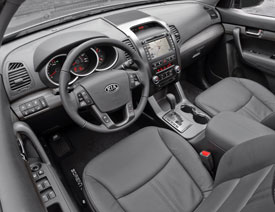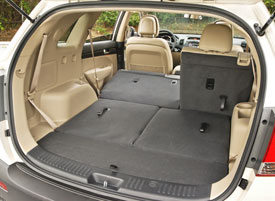2011 Kia Sorento
It’s a clear sign of the times. Kia, responding to current market tastes, has redesigned their compact Sorento without its original body-on-frame SUV chassis, opting instead for a crossover utility unibody. Now Kia hopes this move will greatly expand the Sorento’s appeal. But does being more like a car, and less like a truck, make for a better Sorento?
Besides its chassis transformation, the second generation 2011 Kia Sorento is also the Korean brand’s first vehicle to have its assembly transferred to American soil. That takes place at a huge new facility in West Point, Georgia.
Still, Sorento enters an already crowded compact CUV segment, and faces stiff competition from other quality entrants like the Toyota RAV4, Nissan Rogue, and also new Chevrolet Equinox. Like the Equinox, the Sorento is called a compact, but it’s nearly mid-size both outside and inside. Using a chassis shared with the Hyundai Santa Fe, Sorento’s length of 183.9 inches is over three inches longer than before, if slightly lower for better aerodynamics.
The totally refashioned exterior echoes Kia’s new, bolder, front-end theme begun with the Forte. The grill and flared-back headlights form a continuous arch that is most appealing.
 Based on the KND-4 concept from the 2007 Los Angeles Auto Show, the production Sorento has a similar sweeping profile and athletic stance. Roof rails are optional. The rounded rear-end also exudes lots of presence, with large LED taillights that extend into the liftgate. Wheels are 17 and 18-inch alloys, with a mirror finish optional on top EX trim.
Based on the KND-4 concept from the 2007 Los Angeles Auto Show, the production Sorento has a similar sweeping profile and athletic stance. Roof rails are optional. The rounded rear-end also exudes lots of presence, with large LED taillights that extend into the liftgate. Wheels are 17 and 18-inch alloys, with a mirror finish optional on top EX trim.
While the original Sorento offered a pair of V6s, the 2011 allows a more varied choice. Standard is a 2.4-liter inline-4 shared with the Forte SX. Output is 175 horsepower and 169 pound-feet of torque.
Optional is an all-new 3.5-liter V6 with a best-in-class 276 horsepower and 248 pound-feet of torque. But even with it, trailer towing takes a beating: 3,500 pounds, down from 5,000 last year.
A six speed manual is standard with the I-4. Kia’s first home-grown six-speed automatic is an option, and standard with the V-6. A single speed four-wheel drive system with locking center differential can be fitted to either engine. And, even with front drive, useful Hill Start Assist and Downhill Brake Assist are included.
Government Fuel Economy Ratings for our front-drive four-cylinder automatic are good at 21 city/29 highway on regular gas. We saw a respectable 24.3 miles per gallon in real world driving. But, you do pay for that efficiency on the track. Our I-4 Sorento huffed from 0 to 60 in a long 10.1 seconds. And the quarter mile dragged out to 17.7 seconds at 78 miles per hour. The Sorento felt breathless all the way down the track. Shifts were lazy and power-robbing.
 The Sorento’s new unibody employs a MacPherson strut front, and multilink rear suspensions. Electronic Stability Control is standard.
The Sorento’s new unibody employs a MacPherson strut front, and multilink rear suspensions. Electronic Stability Control is standard.
Unfortunately, none of this helped inspire a high level of confidence in our handling tests. Steering was quick enough but with little feedback, and body roll was excessive.
The one bright spot in Sorento’s track performance was braking. The all-disc, ABS brakes delivered arrow-straight, near fade-free stops of a short 120 feet on average from 60 to 0. The pedal was firm with positive feedback.
On normal roads, the Sorento is a lot more self-assured. It’s comfortable and quiet, feeling well anchored at even elevated interstate speeds.
That comfort continues inside, where Kia used the extra body length for more cabin space and versatility. With both five- and first time three-row seven-passenger models, it’s now a big family-mover. The modern, tech-inspired dash is defined by overlapping gauges and practical controls. Our EX model’s well-padded seats came with standard eight-way power for the driver, and optional heat.
Standards include a tilt/telescoping wheel with audio and Bluetooth controls. Satellite Radio and a USB port are on board too. A 550-watt Infinity upgrade, navigation, and even a dual sunroof, are available. Our EX added push button start, and a backup camera with rear view mirror display.
Those in the 60/40 second row will find it quite roomy, with a welcomed increase in legroom. Kids will like the 50/50 split folding third row, but not adults. Behind the third row is 9.1 cubic feet of space that expands to 37 cubic feet when folded, and an excellent 72.5 with all seats down. A reversible load floor and handy underfloor compartment add to this CUV’s overall practicality.
And that practicality also speaks to Kia’s value pricing. In fact, the base price for the 2011 Sorento is down from last year starting at $20,790. Sorento base prices top out at $29,690.
Combine that with Kia’s vastly improved quality reputation, and one of the best warranties going, and it’s no wonder they continue to chalk up sales gains. The new Sorento’s track performance may be lacking, but we have no qualms with its packaging. So, the 2011 Kia Sorento is indeed a better answer to what today’s family buyers want. And, yes, it’s a better Sorento, too.
Specifications
- Engine: 2.4-Liter Inline-4
- Horsepower: 175
- Torque: 169 Lb Feet
- 0-60 MPH: 10.1 Seconds
- 1/4 Mile: 17.7 Seconds @ 78 MPH
- 60-0 MPH: 120 Feet
- EPA: 21 MPG City/ 29 MPG Highway
- Mixed Loop: 24.3 MPG
2024 Polestar 2
More Range And More Power For The Polestar 2
Volvo is well on their way to making the transition to an all-electric brand, but their sister-brand Polestar is already there. Now, we’ve spent lots of time in their all-wheel drive, five-door Polestar 2, having tested it in 2021, and a year later when a two-wheel drive version arrived. But, EV updates are coming quickly. So, let us be your guide for all that’s new with the Polestar 2.
While we are driving more EVs than ever, we’ve also been spending a lot of time recently circling back to ones we’ve previously tested. As in this new era of electrified vehicles, significant updates are arriving quickly, with R&D investments increasing and retrofitting them easier than ever. This is often done through software updates that can even be accomplished over the air. For 2024, the Polestar 2 has indeed gotten some software updates, but some physical ones as well.
Clearly aimed directly at Tesla’s Model 3 when it arrived; the Polestar 2’s build quality was vastly better, but range definitely came up short. So, addressing that was priority No. 1; and for ’24 the Polestar can travel up to 20% farther than before while consuming 9% less energy, and when it comes time to charge it back up, it can do that 34% faster too.
Range in the Single Motor version increases from a max of 270 to 320 miles thanks to a larger 82-kWh battery pack, and that solitary motor now powers the rear wheels, not the front wheels. It’s also bigger, coming in at 220 kW compared to the previous 170 kW front-wheel drive version, going from 231 to 299 horsepower.
Dual Motors keep the same 78-kWh battery, but still sees a boost from 260 to 276 miles and takes advantage of the larger rear motor for a new combined 310-kW output with 421 horsepower. Our test car has the added Performance Pack, which uses an additional 35 kW to deliver 455 horsepower and 546 lb-ft of torque, though max range drops to just 247 miles.
The new battery in rear-drive 2s will also charge faster, now accepting up to 205 kW for an 80% charge in 20 minutes; max for dual-motors stays at 155 kW, which puts an 80% charge at 34 minutes. Using 32 kWh of electricity per 100 miles, the Dual Motor earns a good efficiency rating.
The [Polestar] 2 has always been one of the most enjoyable EVs to drive, even more so now with that additional power coming from the rear motor.
Unfortunately, extremely cold temperatures kept us from seeing that increased range, as we were only on pace for about 194 miles in our test.
The 2 has always been one of the most enjoyable EVs to drive, even more so now with that additional power coming from the rear motor. And especially when equipped with the Performance Pack as it not only includes more power, but adds 20-inch forged wheels, upgraded brakes, and adjustable Ohlins Dual Flow Valve performance dampers. It greatly improves handling prowess without affecting ride quality, and is easily worth the $5,500 charge if you at all enjoy driving.
Even on a 20-degree track day there was plenty of grip through our handling course. No understeer or oversteer, and lots of feedback through the wheel. There was a nice, strong launch off the line that properly planted us firmly in the seat, and rocketed us to 60 in 4.5 seconds. Power delivery stayed pretty intense up until about 80 mph when there was a definite tapering off. Still, it was a 13.4-second quarter-mile at 102 mph; smooth, quiet, and stable the whole way.
When this car debuted, its Google-based infotainment setup was a novelty, but since then, more and more manufacturers are just “Googling it” so it doesn’t seem out of place at all. The wireless phone charger is easy to access, and there’s a great Harmon/Kardon sound system and panoramic sunroof to enhance the in-cabin experience. Exteriors have also been enhanced with a smooth grille insert and new wheel choices.
Hatchback practicality means 14.3 cu-ft of easy to access cargo space with split-folding seatbacks for longer items and expanding the space to 38.7 cu-ft. Plus, there’s even a sizeable storage bin up front under the hood.
Single Motor Polestar 2 pricing now starts at $51,300, with Dual Motors starting at $56,700; topping out at $64,400.
For a car manufacturer that hasn’t even been around for a decade yet, Polestar has kept itself busy, totally transforming their latest model in just a few years, making the 2024 Polestar 2 even more appealing. They are certainly off to a good start, and with a host of Polestars just over the horizon, including some all-important utility vehicles, this star will be shining even brighter.
Specifications
As Tested
- Motor Setup: Dual Motor
- Horsepower: 455
- 0-60 mph: 4.5 seconds
- EPA Range: 247 miles
- Efficiency : 32 kWh / 100 miles
- Battery Size: 78-kWh
- Torque: 546 lb-ft
- 1/4 Mile: 13.4 seconds at 102 mph
- MW Test Loop: ~ 194 miles
- Peak Charging Rate: 155 kW











































